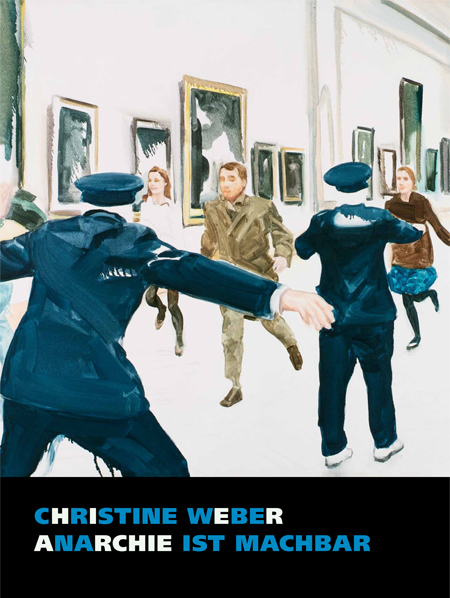
ANARCHIE IST MACHBAR
Christine Webers Gemälde zeigen eine Welt des Kinos
Christine Weber’s paintings portray a world of cinema and
und der Macht. Ihr Material sind die Filme Jean-Luc Godards.
Ikonische Szenen aus Die Außenseiterbande, Die Verachtung
oder Elf Uhr nachts werden zitiert, verfremdet, in ein neues
Licht getaucht. Dieser Bezug ist präzise gesetzt: Godard liebt
die Malerei. Kaum einer anderen Kunst hat er in seinen Filmen
größere Aufmerksamkeit geschenkt als diesem Medium. So
knallen in seinen Werken aus den 60er Jahren die Farben und
bunten Bildzitate einem förmlich um die Ohren, werden Teil
einer politischen Agitation, die das Kino im tiefsten Inneren
erschüttert. Die Utopie einer Freiheit wider die Diktaturen mit
ihren Aufmärschen und Paraden, die Kritik am bürgerlichen
Kapitalismus, all das koppelt Godard in seinem Kino, einem
Kino fernab von Hollywood, an eine Begeisterung für die Malerei.
Er liefert damit eine Fundamentalkritik am Betriebssystem Kunst
und dessen Regeln der Vermarktung. Seine Helden sind Outlaws,
die nicht nur Picasso schätzen, sondern auch in Comics blättern
und sich an der Ästhetik der Werbung berauschen. In diesen
Zwiespalt der Moderne mit seiner Unterscheidung von High und
Low greifen die Gemälde von Christine Weber ein. Ihre Bilder
trennen nicht zwischen politischer und cineastischer Wirklichkeit.
Ganz im Sinne Godards schaffen sie eine Realität, in der das
Utopische und Persönliche zu einem totalen Tableau verschmilzt.
ANARCHY IS DOABLE
of power. Weber draws on the films of Jean-Luc Godard as
material inspiring her work. Iconic scenes from Band of
Outsiders, Contempt, or Pierrot le Fou are cited,
estranged and bathed in a new light. This reference is
particularly apt: Godard has a particular affinity with
painting. He gave more attention to this art form than any
other in his films. In his works from the 60s, the colors and
various image references explode all around you, becoming
part of a political agitation that shook cinema to its depths.
The utopia of freedom in contrast to dictators with their
marching and parades, a criticism of bourgeois capitalism,
Godard coupled all this in his films, a cinema far from
Hollywood, with his enthusiasm for painting. In this way
he delivered a fundamental criticism of the art world and
its rules of marketing. His heroes are outlaws, who not
only admire Picasso, but also flip through comics and find
themselves enthralled with the aesthetics of advertising.
The paintings of Christine Weber intervene in this dichotomy
of the Modern with its differentiation between high and low.
Her images do not distinguish between political and cinematic
reality. True to the spirit of Godard, they create a reality
in which the utopian and the personal merge into a grand
tableau.